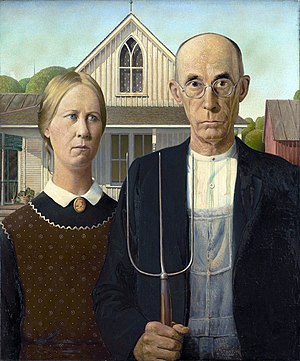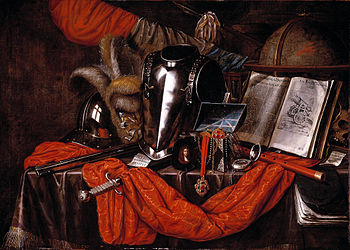For another similar discussion of iconography in art, view and listen to art historians talk about Robert Campin’s Mérode Alterpiece.

Grant Wood, American Gothic, 1930, oil on beaver board, 78 × 65.3 cm, The Art Institute of Chicago, Chicago
You can see how densely populated iconography in imagery can convey specific hidden meanings. The problem here is to know what all of this means if we want to understand the work. Another more contemporary painting with many icons embedded in it is Grant Wood’s American Gothic from the 1930’s. The dour expressions on the figures’ faces signify the toughness of a Midwestern American farm couple. Indeed, one critic complained that the woman in the painting had a “face that could sour milk”. Notice how the trees and bushes in the painting’s background and the small cameo the woman wears mirror the soft roundness of her face: these traditional symbols of femininity carry throughout the work. In contrast, the man’s straight-backed stance is reflected in the pitchfork he holds, and again in the window frames on the house behind him. Even the stitching on his overalls mimics the form of the pitchfork. The arched window frame at the top center of the painting in particular is a symbol of the gothic architecture style from 12th century Europe.

Edward Collier, A Vanitas, 1669, oil on canvas, 33 × 46.5 cm, Denver Art Museum, Colorado, USA
In addition, a popular genre in painting from 16th century northern Europe, especially the Netherlands, is known as vanitas painting. These still life paintings are heavily dependent upon symbolic objects that project the joy and accomplishments life affords us, yet at the same time remind us of our mortality. Edward Collier’s painting is a good example of how crowded these could be.
The armor, weapons and medals show a focus on military accomplishments. The open book alludes to knowledge and in this case, the drawing of a canon mirrors the overall theme. The globe is a symbol of both travel and our common existence as earth-bound beings. Contemporary vanitas paintings could certainly include allusions to air and space travel. On the far right of the work, behind the book and in the shadows, lies a skull, again reminding us of the shortness of life and the inevitability of death.
We can use iconography to find meaning in artworks from popular culture too.
-
The “Golden Arches” mean fast food.
-
The silhouette of an apple (with a bite out of it) means a brand of computer.
-
A single, sequined glove stands for Michael Jackson, the late ‘king of pop.’
-
The artist Andy Warhol’s soup can image forever links Campbell’s soup with Pop Art.
Introduction to Iconography
At the simplest of levels, iconography is the containment of deeper meanings in simple representations. It makes use of symbolism to generate narrative, which in turn develops a work’s meaning. Each of the objects in the Arnolfini Portrait shown above has a specific meaning beyond their imagery. In fact, this painting is actually a painted marriage contract designed to solidify the agreement between these two families. It is especially important to remember that this is not a painting of an actual scene, but a constructed image to say specific things.
Iconography in art
For another similar discussion of iconography in art, view and listen to art historians talk about Robert Campin’s Mérode Alterpiece.
You can see how densely populated iconography in imagery can convey specific hidden meanings. The problem here is to know what all of this means if we want to understand the work. Another more contemporary painting with many icons embedded in it is Grant Wood’s American Gothic from the 1930’s. The dour expressions on the figures’ faces signify the toughness of a Midwestern American farm couple. Indeed, one critic complained that the woman in the painting had a “face that could sour milk”. Notice how the trees and bushes in the painting’s background and the small cameo the woman wears mirror the soft roundness of her face: these traditional symbols of femininity carry throughout the work. In contrast, the man’s straight-backed stance is reflected in the pitchfork he holds, and again in the window frames on the house behind him. Even the stitching on his overalls mimics the form of the pitchfork. The arched window frame at the top center of the painting in particular is a symbol of the gothic architecture style from 12th century Europe.
In addition, a popular genre in painting from 16th century northern Europe, especially the Netherlands, is known as vanitas painting. These still life paintings are heavily dependent upon symbolic objects that project the joy and accomplishments life affords us, yet at the same time remind us of our mortality. Edward Collier’s painting is a good example of how crowded these could be.
The armor, weapons and medals show a focus on military accomplishments. The open book alludes to knowledge and in this case, the drawing of a canon mirrors the overall theme. The globe is a symbol of both travel and our common existence as earth-bound beings. Contemporary vanitas paintings could certainly include allusions to air and space travel. On the far right of the work, behind the book and in the shadows, lies a skull, again reminding us of the shortness of life and the inevitability of death.
We can use iconography to find meaning in artworks from popular culture too.
The “Golden Arches” mean fast food.
The silhouette of an apple (with a bite out of it) means a brand of computer.
A single, sequined glove stands for Michael Jackson, the late ‘king of pop.’
The artist Andy Warhol’s soup can image forever links Campbell’s soup with Pop Art.
Content is available under the
Creative Commons Attribution Share Alike License.
Privacy Policy | Authors